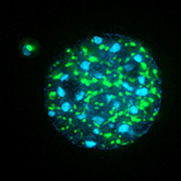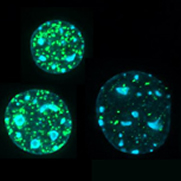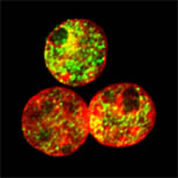Ian Cowell
Institute for Cell and Molecular Biosciences
Newcastle University E-mail ian.cowell@ncl.ac.uk
Research Interests - Chromosomes, chromatin dynamics and genome stability.
The genetic material of eukaryotic cells is organized into chromosomes. These highly organized but dynamic structures support the stable maintenance and faithful replication of the genome, while at the same time permitting transcription and the execution of genetic programs. How these processes occur and how they are coordinated are fundamental questions in modern biology, with great significance for the understanding of conditions such as cancer and aging.
Mechanisms of chromosomal translocation in leukaemia.
Therapy-related leukaemia is a rare but unfortunate side effect of otherwise successful treatment for primary cancers using DNA damage-inducing anti-cancer drugs [Cowell & Austin 2012]. Leukaemia cells from these cases display chromosome aberrations, including characteristic recurrent chromosome translocations, and these genetic lesions are thought to be causative or at least early contributory events in the generation of these leukaemias. Preciesely how and why recurrent translocations occur in therapy-related and de novo leukaemia is unknown, but the mechanism presumably involves chromosome breakage and incorrect rejoining. A major part of our current work is supported by Bloodwise (formerly known as Leukaemia and Lymphoma Research ) programme grant funding. We are investigating how anti-TOP2 drugs used in primary cancer therapy can contribute to therapy related leukaemia [see Cowell and Austin for review] with the aim of identifying strategies that can reduce the rate of this devastating side effect, while maintaining the efficacy of current anti-cancer therapies. We have recently shown that TOP2B is responsible for the genotoxic properties of etoposide using a cell line model [Cowell et al 2012], and gathered evidence for a transcription-related mechanis for generating chromasome translocations [Cowell and Austin 2012]
Changes in chromatin and nuclear organization associated with DNA damage and genome stability.
The histone variant H2A.X is rapidly phosphorylated after cellular exposure to DNA-damaging agents such as ionizing radiation or the topoisomerase poison etoposide, resulting in chromatin domains enriched for phosphorylated H2A.X (gammaH2AX) around sites of double-strand DNA breaks. I previously showed that heterochromatin is a barrier to H2AX phosphorylation [Cowell et al 2007], and work subsequently published in Molecular Cell and Nature has confirmed this, showing that removal of the heterochromatin protein HP1 is a necessary part of the DNA damage response. Histone deacetylase inhibitors (HDACIs) cause histone hyperacetylation and alter the properties of heterochromatin relieving the block to H2AX phosphorylation. DNA topoisomerase II poisons such as etoposide are mainstream cytotoxic anticancer drugs, and recently it has been shown that their cytotoxic effects can be potentiated by HDACIs. The interaction of HDACIs and other drugs such as DNA topoisomerase II poisons ios a current area of interest and we have recently shown that HDACIs cause a redistribution of TOP2B from heterochromatin to euchromatin in mouse cells and a change in the genomic distribution topoisomerase-mediated DNA damage [Cowell et al 2011].
Targeting DNA-repair proteins as a means to improve the efficacy of anti-cancer treatments.
I contributed to work validating the PIKK kinases DNA-PKcs and ATM as drug targets for anti-cancer therapies [Cowell et al 2005, Zhao et al 2006, Willmore et al 2008] with Drs Durkacz and Wilmore in the NICR at Newcastle on an LLR-funded project to determine the role of DNA damage-inducible kinases in the cellular responses to nucleoside analogues used in leukaemia therapy.
Histone lysine methylation and the function of chromodomain proteins.
Work I started at Newcastle and then continued at the Babraham and the Roslin Institutes focused on histone modifications and the function of chromodomain proteins [Cowell & Austin 1997; Jones et al 2000; Wang et al 2000; Kourmouli et al 2000; Cowell et al 2002]. Chromodomain proteins, particularly the heterochromatin protein HP1 bind to, and form the “readout” for modifications including trimethylation of histone H3 at lysine 9. I was amongst the first to report the evolutionarily widespread occurrence of chromatin domains enriched for histone H3 trimethylated at lysine 9, and the association of this epigenetic modification with heterochromatin and a transcriptionally silent state [Cowell et al 2002]. Current work includes studying the relationship between the epigenetic status of genomic regions and their response to DNA damage induced by agents such as topoisomerase II poisons or ionizing radiation [Cowell et al 2011]



